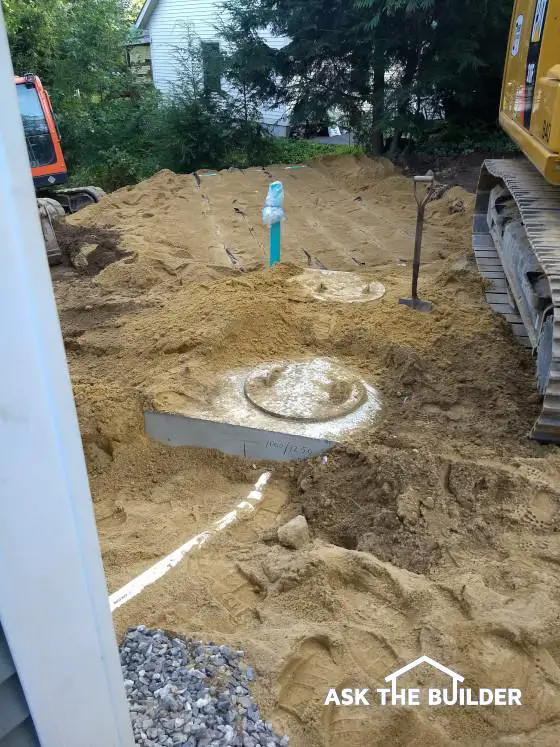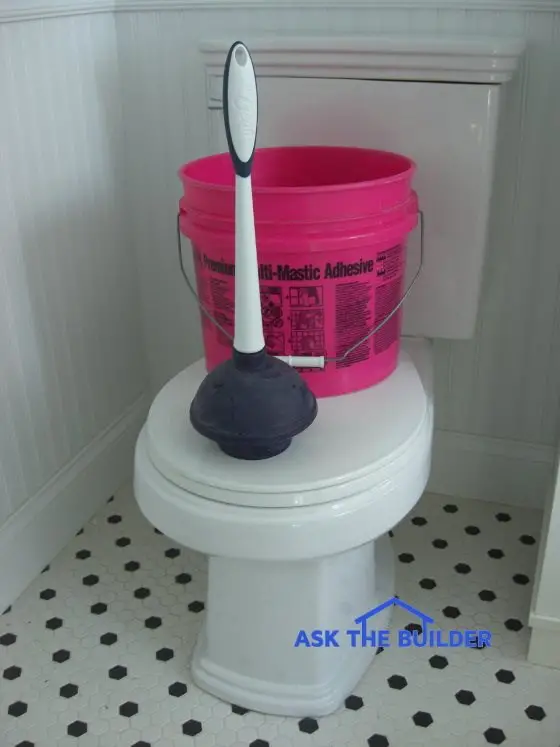
Prevent Sewer Backup | This is a sewer pipe leaving a house and entering a septic tank. It's easy for a pipe like this to back up.
"I also flush the toilet each time I walk by it even if it has clear water in it."
Prevent Sewer Backup By Flushing More Often
You can prevent sewer back up in many houses by just adding more water to your plumbing drain system.
Why Does my Sewer Backup?
Sewer backups happen for many reasons:
- tree roots in a sewer pipe
- broken sewer pipe
- sewer pipe with not enough slope
- too little water to push waste and paper to sewer or septic tank
Tim, Has Your Sewer Backed Up and Why?
Yes, in the past four years my own sewer under my house has backed up four times. It all started happening after I installed a new low-flush toilet in my basement bathroom.
The toilet has a flushing mechanism where a quick push only delivers a small amount of water for removing liquid body waste. You need to hold down the handle to put a full 1.6 gallons of water into the drain to remove solid body waste. My son and wife were not holding down the handle long enough.
CLICK or TAP HERE to get FREE BIDS from sewer cleaning companies.
What's the Easiest Way to Prevent Sewer Backup?
The easiest way to prevent sewer backup is to add more water to the system to ensure the waste makes it all the way to the city sewer line or your septic tank. Modern low-flush toilets are causing all sorts of problems in many homes because they simply don't provide enough water to get the waste to where it needs to be.
I now pour ten gallons of water into my toilet each week as you see in this video to prevent sewer backup. Ten gallons of water weighs 83.2 pounds. If you remember your high school physics, you know that Force = mass (weight) times acceleration.
Eighty-three pounds of water falling ten feet down a plumbing stack and then racing down a pipe towards a city sewer or septic tank has lots of force is all you need to know.
I also flush the toilet each time I walk by it even if it has clear water in it. WATCH the flushable wipes video too just below.
How Much Does it Cost to Flush a Toilet?
If you have a private well as I do, you get your water for free. I only have to pay a tiny fraction of a penny for the electricity to get water from my well into my home. It's such a small amount of money, you simply can't comprehend it.
A very good friend of mine lives in Cincinnati, Ohio and uses water from a public utility. I used the rate chart they provide and did the math. She only has to pay just under eight-tenths of a penny ($0.0077) each time she flushes her 1.6-gallon toilet.

You often don’t need a plunger to unclog a toilet. Just use 3 or 4 gallons of water from a bucket. (C) Copyright 2020 Tim Carter
However, she also has to pay to get rid of the water. The sewer district bases her sewer bill on the amount of water she discharges into the sewer system. The sewer charge is about 2.82 times the water bill. Thus each time she flushes the toilet, it costs her $0.02247 or just over two cents.
Doesn't Using All This Extra Water Defeat the Purpose of Low-Flush Toilets?
Yes, it does. But use some critical thinking skills here before jumping to conclusions. Not everyone needs to use low-flush toilets, right?
I'm on a private well. I have unlimited water at my house. Why should I be forced to use a low-flush toilet?
What's more, as soon as the water from my toilet enters my septic tank, the SAME VOLUME of water exits my septic tank and re-enters the ground!
The same thing happens if you live in a large city that gets its water from a river like Cincinnati. The only way there could be a water shortage is if the Ohio River dries up. The chances of that happening are so small as to be irrelevant. And don't forget, the Cincinnati Metropolitan Sewer District discharges the SAME VOLUME of water back into the Ohio River as is being taken out upstream by the Cincinnati Water Works!
The only people that need low-flush toilets are those that choose to live in arid locations where water is in short supply. If they want to conserve water then they can use a bucket to flush their toilets only using as much water as they feel they need to use. Forcing ALL of us to use low-flush toilets is simply unacceptable.
If an area is growing, then they just have to increase the capacity of their water treatment plants to meet the demand. This has happened as all cities have grown.
Related Link
Fixing Low-Flush Toilet Problems
CLICK or TAP HERE to get FREE BIDS from sewer cleaning companies.
The post Prevent Sewer Backup appeared first on Ask the Builder.
Via builders feed http://www.rssmix.com/
No comments:
Post a Comment